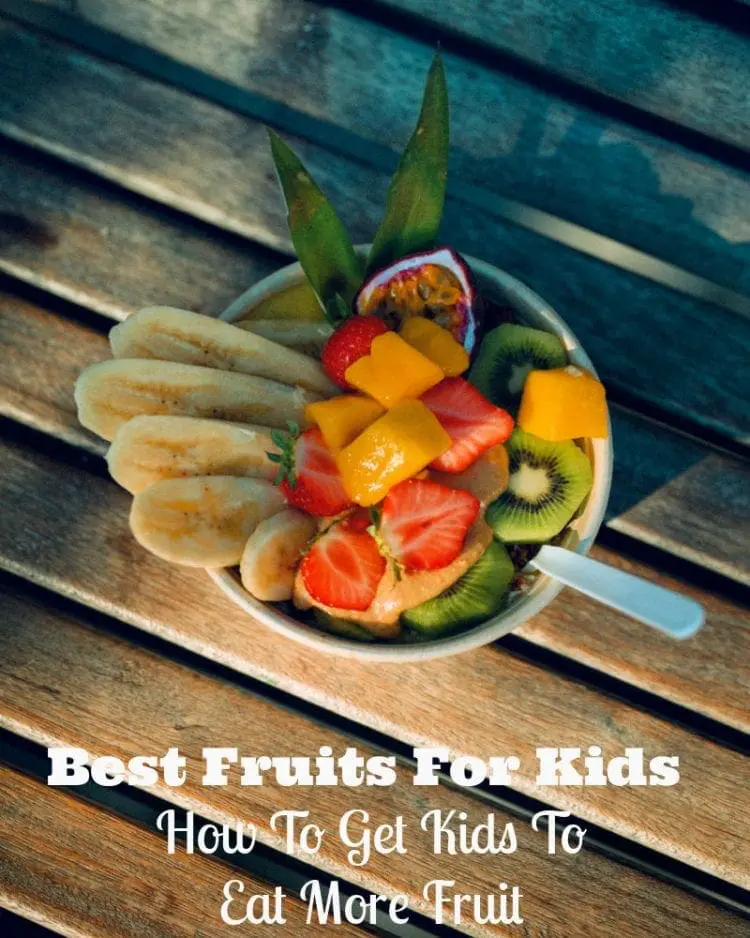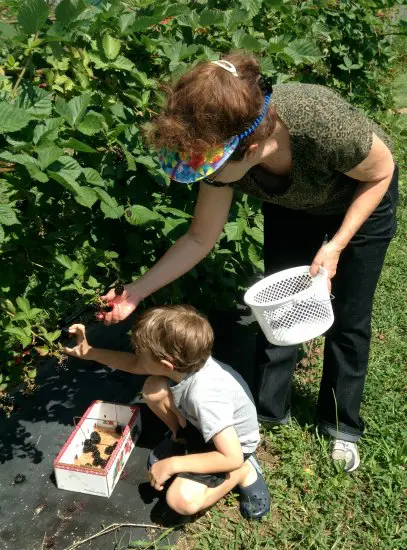Introducing more fruit into your child’s diet is a great way to increase the vital nutrients they consume. Eating fruits is great for kids because they’re packed with essential vitamins, minerals, and fiber that help support healthy growth and boost the immune system. Plus, the natural sugars in fruits provide energy without the crash that comes from processed snacks. While more whole fruits are a healthy choice, actually convincing your child to eat more fruits can sometimes be a challenge. Rather than forcing your child to eat more fruits, consider these fun and easy alternatives to increase your child’s fruit consumption. Choosing the right fruit for kids as well as offering an appealing presentation can go a long way.
Fruits For Children

You may (or may not) be surprised to learn that most kids aren’t getting enough fruits in their diet. In fact, the CDC says, “Sixty percent of children did not eat enough fruit to meet daily recommendations in 2007-2010.”
You may be wondering, “How much fruit should a child eat a day?” That is a great question. Why try harder than you need to? You have probably heard that kids should eat 5-9 servings of fruit and veggies per day. To make that easier to visualize and act upon, myplate.gov says, “The amount of fruit you need to eat depends on age, sex, and level of physical activity. The amount each person needs can vary between 1 and 2 cups each day.”
How many servings of fruit per day for kids?
My Plates goes on to elaborate that toddlers ages 2-3 should consume 1 cup of fruits per day. While kids ages 4-8 should consume 1-1 1/2 cups per day. Girls 9-18 should consume 1 1/2 cups of fruits per day. Boys 9-13 should consume 1 1/2 cups per day and boys 14-18 should consume 2 cups.
This refers to fresh fruit, not fruit juice. Processed fruit juice from bottle has a very high sugar content but no fiber and the nutrient value is much diminished.
Best Fruit For Child Growth
What fruit is good for kids? Why are fruits important for children and which one are best? Well, fruits provide essential nutrients that are vital to the health and maintenance of our body but often under-consumed. In fact, as My Plate points out, “people who eat more fruits and vegetables as part of an overall healthy diet are likely to have a reduced risk of some chronic diseases”.
Vitamin C is important to the growth and repair of all body tissues. As MedlinePlus says, Vitamin C is used to “form an important protein used to make skin, tendons, ligaments, and blood vessels…[and] repair and maintain cartilage, bones, and teeth.”
Best fruits for kids that are rich in vitamin C include:
- Cantaloupe
- Citrus fruits and juices, such as orange and grapefruit
- Kiwi fruit
- Mango
- Papaya
- Pineapple
- Strawberries, Raspberries, Blueberries, and Cranberries
- Watermelon
Diets rich in potassium may help maintain healthy blood pressure. Fruits for kids that are rich in potassium include:
- bananas
- prunes
- dried peaches
- dried apricots
- canteloupe
- honeydew melon
The health benefits of fruits also include high levels of antioxidants. Be sure to include delicious fruit in a balanced diet to meet kid’s nutritional needs.
5 Ways To Incorporate More Fruits in Your Child’s Diet AKA How To Get Child To Eat Fruit

Encouraging kids to eat more fruit can be as simple as getting creative with presentation—think colorful fruit salads, fun skewers, or blending fruits into tasty smoothies. Involving children in shopping and preparation also makes them more excited to try new fruits and enjoy them as part of a healthy snack or meal.
Make Snacking on Fruits Easy
Oftentimes, fruit isn’t thought of as a to-go snack because there are so many other easy options. Rather than fighting crackers and gummies as the top choice in your child’s snacking habits, pare down on alternative snacks and make colorful fruits front and center. Divide fruit servings into individual portions and remove other types of snacks from the house. Also, take fruit out of the crisper and place it at eye level in the fridge. By reducing the amount of snack options available and making fruit an easy choice, kids will naturally eat more fruit.
Fruit Kababs For Kids
If you are thinking, “My child hates fruit,” you may be surprised how much an appealing presentation can do. One way to make snacking on a variety of fruits easy is to have fruit kabobs for kids on hand in a tupperware container that kids get easily chose for a snack. Such pretty colors and shapes on the fruit kebabs for kids make them appealing as does the fun of being able to eat off a stick or toothpick! There are endless ideas for how to make fruit kebabs for kids. Load toothpicks with grapes. Create rainbow fruit kabobs. See what your kid responds to and enjoys most. Picky eaters will often try new foods if it is presented in fun ways.
Blend a Smoothie
Fruit drinks may seem healthy, but in actuality they are loaded with sugar and chemicals. A simple way to diversify your child’s drink options and incorporate more fruit into their diet is to make fruit smoothies. Throw fruits in the freezer or place them in a blender with a cup of ice. Get creative with your smoothies by blending banana and strawberry or kale and blueberries together. Smoothies are fun, satisfying drinks that promote healthy eating habits.
Serve Fruits with a Dip
If making individual portions of fruit still isn’t moving it from your fridge, create a dip to encourage an increase in fruit intake. Mix marshmallow crème with cream cheese or add some chocolate syrup or coconut to plain Greek yogurt to offer kids a fun, sweet and tasty to dip for their fruit.
Pick Your Own Fruit
Making fruit fun can be as easy as taking kids out to local farms to see how it’s produced. A pick-your-own afternoon adventure is a great way to introduce young children to farming and encourage them to eat more fruit. In the spring, find farms that offer pick-your-own strawberries, blackberries and blueberries. In the fall, apples and figs are popular choices. Not only are these farms a fun afternoon activity, they also encourage children to eat more fruit by integrating them into the process of harvesting the produce and enjoying the bounty.
Let Kids Play with Their Food
Rather than just insisting that kids eat their fruit, make the preparation of their snack more engaging to increase their intake. During the summer, have a kebob night where meat and veggies are grilled over the fire and fruit kebobs are prepared for dessert. Another fun idea is for parents to slice fruits like watermelon, cantaloupe and honeydew into 1/2 inch thick sheets and let the kids use cookie cutters to design cute shapes. Top with fruit garnishes and your family has a fun and healthy snack. Engaging kids in the preparation can help increase the amount of fruit they eat.

My daughter once wanted to have a Fruit Club. My kids and I met once a day for a week and tried new, unusual fruits (like passion fruit, dragon fruit, and star fruit). She made notes about what each fruit looked like and how each of us would describe its flavor. Then she drew the fruit. Letting them feel in control of the process, may be just the ticket!
Conclusion
Trying to get your children to eat more fruit to get important nutrients doesn’t need to be a constant struggle. Instead, incorporate a few creative ways to engage children and encourage healthy eating habits. Next time your kids ask what they can have for a snack, point them towards the fruit. Use these easy tips to make a few small changes and your kids will be eating plenty of fruits in no time. What ways seem to work best for you in adding more fruits to your child’s diet?
Related Posts:
10 Healthy After School Snacks


Flora says
Thanks for enriching my everyday life with a blend of practical advice and creative ideas. Different coloured fruits is a good way to get kids interested in eating the rainbow and talking about how each fruit offers different benefits.
Liam says
This article provides a good overview of the importance of fruits for kids and tips on how to incorporate more fruits into their diet. It also includes a list of fruits that are rich in vitamin C, which is an important nutrient for growing children..
John says
Serve Fruits with a Dip. These tips are so amazing. It is the small, simple things that work. Definitely glad to have some new tips.
Rehan says
This article is very helpful and informative. Thanks for sharing this blog with list of fruits that are healthy and high in nutrients. My child loves purple fruits as an afternoon snack. I am trying to expand her favorite fruit list.
Addie says
Healthy fruits will always help to maintain good health. Thanks for sharing these fun fruit ideas for kids.
HQ says
This article offers fantastic ideas for making fruits more appealing to kids! I appreciate creative approaches to encourage healthy eating habits. Incorporating fun presentations like fruit kabobs or smoothies can make a significant difference. Thanks for sharing these practical tips!
Diligence Certifications says
Fruits are nature’s sweetest gift for kids—packed with vitamins, fiber, and antioxidants that support growth and immunity. Finding creative ways to include them, like colorful smoothies, fun fruit kabobs, or tasty yogurt parfaits, makes healthy eating exciting for little ones. It’s all about turning nutrition into a delicious adventure!
Busy Bee Concierge says
Love this! I’ve seen how even small changes like fruit shapes or fun names can make a big difference with kids. As someone who helps busy families in Dutchess County through my concierge service, I’ve noticed that when parents aren’t stuck running errands, they have more time to prep healthy, kid-friendly meals like these. Every little bit counts!